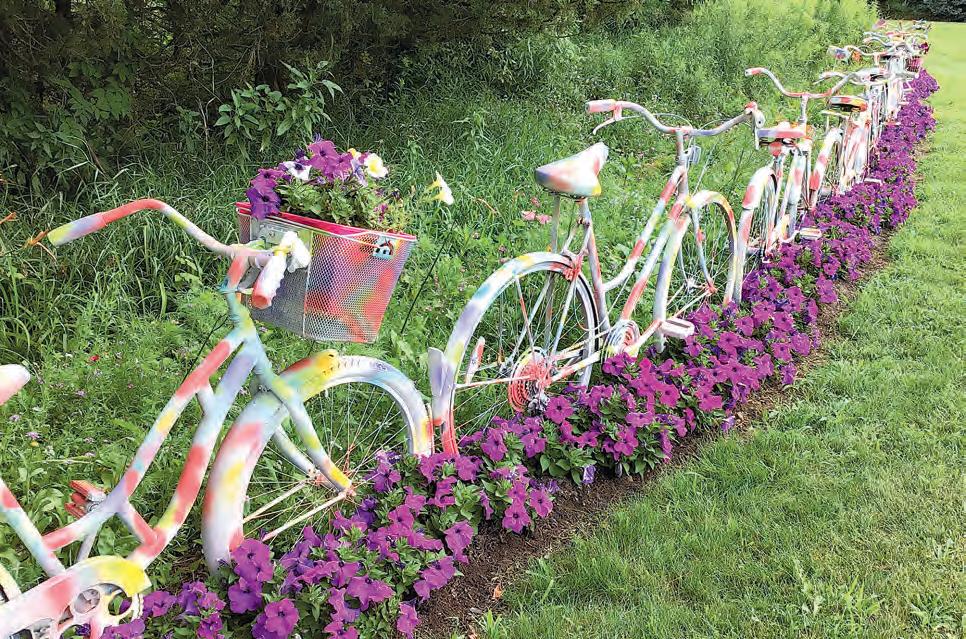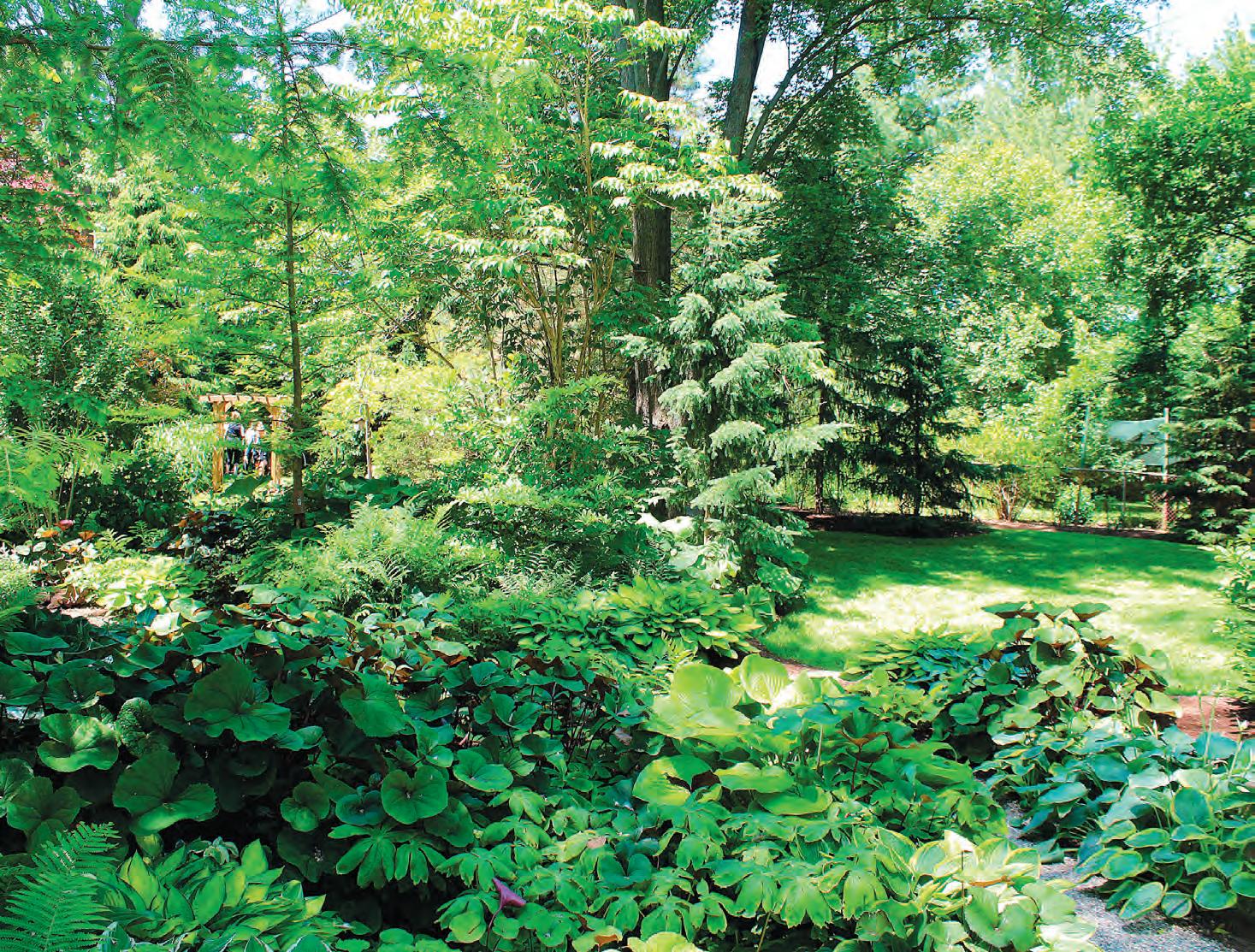6
Michigan Gardener | September/October 2020 | MichiganGardener.com
Trees • Shrubs • Perennials Premium Landscape Supplies: Composted Pine Bark Premium Soils Bulk Michigan Peat Organic Products Flagstone, Limestone & Boulders Campania Fine Garden Statuary
Landscape Design & Installation Services
8215 Elizabeth Lake Rd. • White Lake
248-698-4741 MulliganLandscaping.com
No Gas. No Oil. No Fumes. No Mess.
GREENWORKS® battery-powered lawn mowers, blowers, string trimmers, and edgers deliver the power and performance of comparable gas-powered tools without the mess, noxious fumes, stamina-reducing vibration and noise associated with gas products. For more information, go to: www.GreenworksTools.com
Easy-to-grow, low groundcovers I would love to have creeping thyme or another easy grower in areas in between other plants. I was thinking thyme because I could use it for cooking too. Something low maintenance and that would discourage weed growth. Any advice? J.D., Plymouth Creeping thyme is an easy grower in full sun and should be planted in areas readily accessible to the kitchen. For areas not so close, but also in full sun, consider stonecrops (Sedum). There are a number of low-growing sedums in a variety of colors that form low, dense mats that can keep weeds in check. They are easy to plant, easy to care for, and with their relatively shallow roots, easy to remove and transplant to unfilled areas. Sedums love dry, sunny conditions. Many people use them in place of mulch. It is quite popular to take a variety of sedums and create a patchwork rock garden because there are so many colors and leaf textures. If you have shady conditions, try periwinkle (Vinca minor), also known as myrtle. It tolerates drought, and grows in full sun to part shade. Keep it watered until established. It quickly forms a strong mat over the soil that prevents weed seeds from rooting. Its stems do not become woody and invasive like English ivy. It is still a vine and will want to climb any nearby tree. But it is easily controlled by cutting through the soil and pulling out what is too exuberant. Another low maintenance groundcover is ajuga, or bugleweed, which is tolerant of sun or shade. It is slow to start, but once established, is easily managed by thinning. It grows by surface roots called stolons. Like the vinca, it roots at each node on the stem.
Dealing with quackgrass
FOR A COMPLETE LINE OF GREENWORK S EQUIPMENT, PLEASE VISIT:
1241 W. 14 Mile Rd. Clawson, MI 48017 248-744-6946 www.billingslawn.com
How do I eradicate quackgrass without harming our regular grass? Every year this eyesore takes over my lawn. T.W. Make sure what you have is quackgrass and not crabgrass, which is a reseeding annual. Crabgrass can be controlled with a pre-emergent weed preventative applied in spring. You can check it against pictures on the Michigan State University weed identification website. Quackgrass unfortunately is a perennial weed and successfully grows by rhizomes underground. First, there is mechanical removal—literally digging up the offending patches, removing surrounding soil, adding fresh topsoil and reseeding. This is not fail-safe because quackgrass rhizomes can run 6 to 8 feet. Any piece left behind can sprout a new plant. The second method for quackgrass is chemical control. Only glyphosate (Roundup and other products) will kill this weed and
penetrate through its rhizomes. This is a nonselective herbicide, which means it will also kill the desirable turf grass. There is not an herbicide made for quackgrass specifically. Depending on how much of your lawn is compromised, you may want to treat the larger portions with herbicide, wait a week, re-treat persistent patches, remove the dead grass, add fresh top soil, and reseed. Doing nothing is also an option, since quackgrass is green and mowable and comes back every year. However, most people don’t like the coarse look when compared to our turf grasses. Once you decide how to eradicate your problem, look at your fertilization methods and mowing practices. Quackgrass wins when the turf grass is weak. Fertilize in spring with a balanced nitrogen amendment, apply a pre-emergent for the annual weeds, mow high but frequently to stimulate growth, and deep water when there is drought. Strengthen your existing lawn so that quackgrass and annual weeds can’t make inroads into the soil where good root systems grow.
Overwintering bonsai I received a small dish bonsai as a gift. The instruction sheet says it should be outside for the winter. It does not seem like it will survive winter in its small dish. Suggestions? P.J. The term “winter” is relative, depending on where the bonsai specimen originated, from where it was shipped, and what type of plant it is. You are correct to assume our winter would probably be disastrous for your small-sized specimen. First, determine if you have an indoor or outdoor tree. Outdoor specimens are traditionally juniper, pine, and deciduous species like elm and birch. Indoor specimens are jade plants, Hawaiian umbrella trees, and cute little ficus—all glorified houseplants. Once you know what you have, you could put an outdoor bonsai in fresh air, but do not let it freeze. There are three general rules for all bonsai, which literally means “planted in a container.” 1) Keep your bonsai away from direct heat or drafts. 2) Position it in plenty of indirect sunlight. 3) Give it plenty of humidity to keep its soil moist. The number one culprit of bonsai death is over or under watering. This small pot is a tight environment for roots to grow. You water when the soil feels dry to the touch. This may be daily and cannot be a routine. Provide a good drainage tray and soak the soil until water escapes. Do not let the pot sit in water or the roots cannot get oxygen to grow. Only use fertilizer after thoroughly watering; never on dry soil. If the plant thrives, you will





